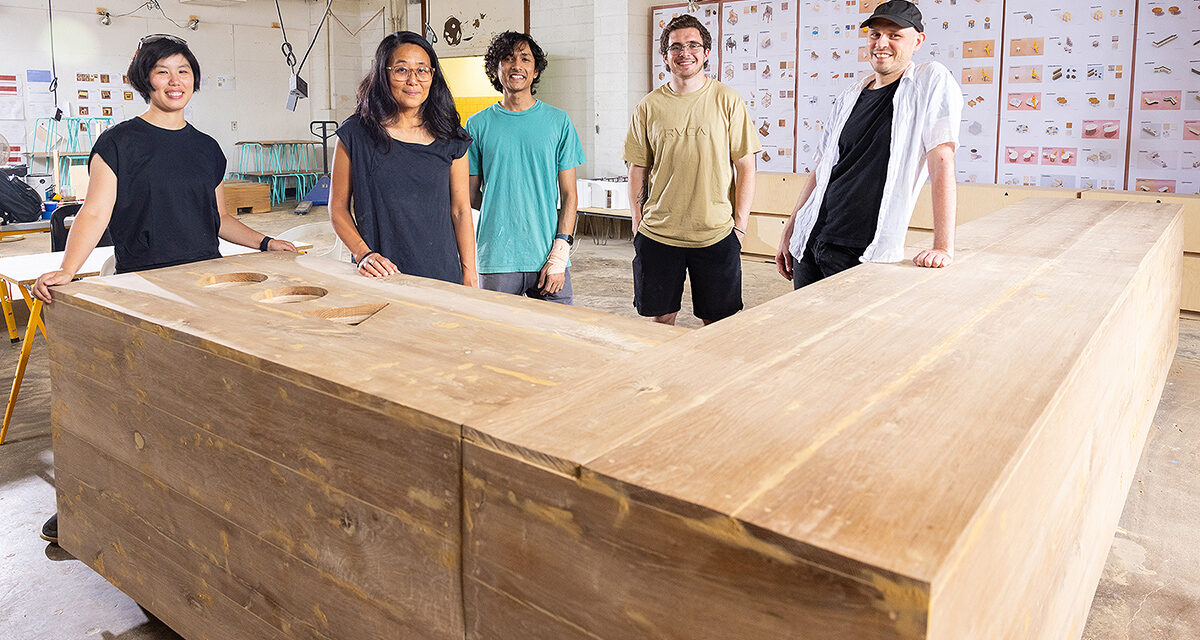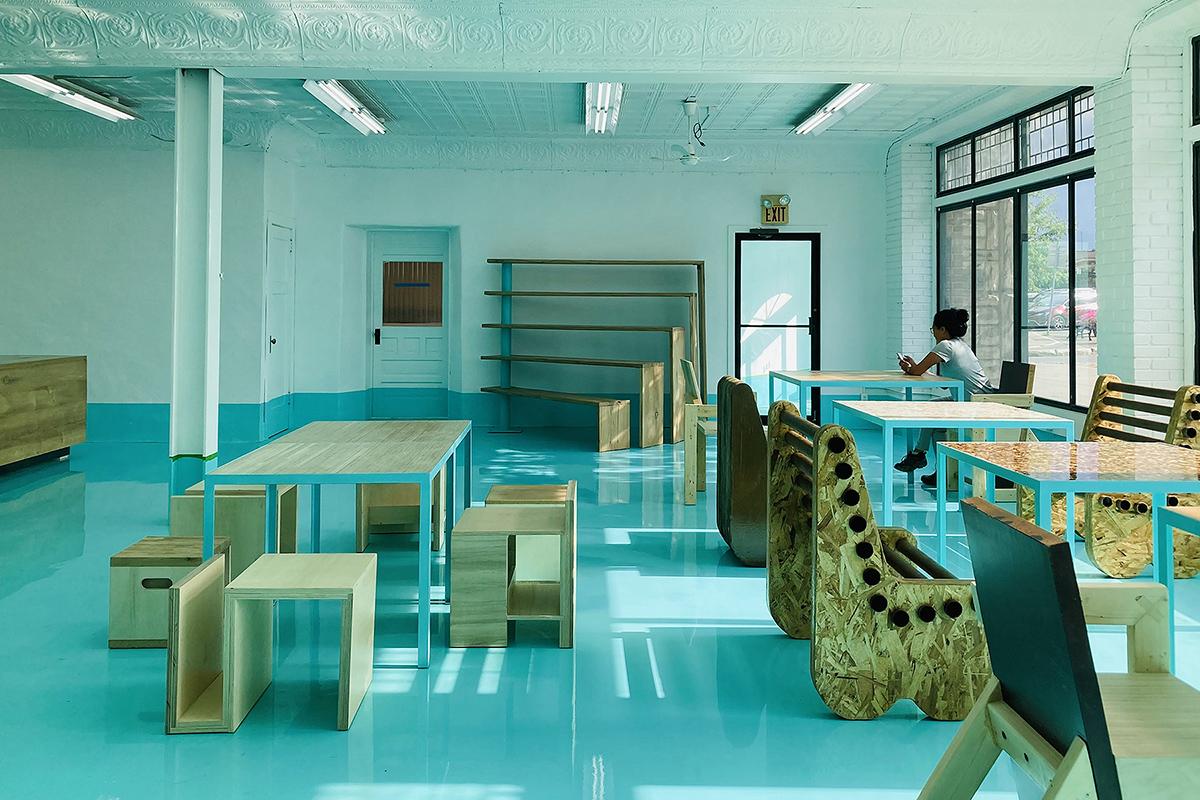‘Objects of Affection’ Transforms Space for Contemporary Art Event

Using everything from upcycled canal lock lumber to salvaged chair legs, UB architecture students and faculty create unique pieces for Medina Triennial Hub
BUFFALO, N.Y. – It’s called “Objects of Affection,” and the space and the furniture within it has certainly been a labor of love for the dozens of University at Buffalo School of Architecture and Planning students and faculty members who designed and built it all for an upcoming art event in Western New York.
They’ve spent the past six months pulling nails from reclaimed wood and then cutting, sanding and refinishing it; reforming metal chair legs pulled from the trash and rebending them to form new stools; and using old blocks of lumber from Erie Canal locks to form tiered seating.
Their work will be on display beginning Sept. 13, when the Medina Triennial Hub — the venue that will serve as a welcome center and programming space for the Medina Triennial — officially opens. The team transformed part of the space at 345 N. Main St., a historic Medina sandstone building that was previously a hotel and then an auto parts store, into the Medina Triennial Hub, which will host public programs and events starting next month, serving as a formal launch for the Triennial’s public engagement.
The Medina Triennial is a new contemporary art event initiated by the New York Power Authority and the New York State Canal Corporation; the inaugural edition will take place from June 6-Sept. 7, 2026 in the village of Medina, situated along the Erie Canal in between Buffalo and Rochester. The Triennial aims to become a cultural touchstone for Western New York, offering a dynamic platform for supporting and advancing the contemporary arts landscape in the region and drawing an expected 50,000 visitors every three years.
Joyce Hwang, professor of architecture at UB and director of the architectural practice Ants of the Prairie, is a member of the Medina Triennial’s steering committee and board. The UB team’s work is being sponsored by the Sydney Gross Memorial Fund, named for the UB architecture student who died the summer before her sophomore year in a car accident in 2009. The fund provided support for a design-build memorial project completed by UB students working with Hwang and Christopher Romano, assistant professor of architecture, along the canal in Medina in 2023.
UB architecture faculty members Maia Peck and Gregory Serweta (co-partners of the architecture practice Serweta Peck) were selected to lead the Medina Triennial Hub design project, which was also supported by the Sydney Gross Memorial Fund, following a call for initial proposals earlier this year.
They led an independent study during the spring semester with 13 students, plus faculty and staff from the school’s Fabrication Workshop and a team of volunteers to design and then build the collection of objects — all made from upcycled and sustainably-minded materials — that will occupy the Triennial Hub.
Serweta Peck will be presenting their design project and giving a tour during The Hub opening at noon on Saturday, Sept. 13. Additionally, UB will be hosting a day of programming Nov. 15 at the Medina Triennial Hub.
The objects include tiered seating made from 17-foot blocks of salvaged Erie Canal lumber, donated by the New York State Canal Corporation, that were used to construct the locks for the canal. The team even fashioned chairs made from upcycled cardboard tubes and plucked metal legs from the trash that are seeing new life as teal-colored stools that will be used in the Hub.
In fact, everything that occupies the Hub was made from salvaged or reclaimed materials. “The students were very inventive in their designs in terms of materials and then form,” says Serweta.
The idea is that breakages or cracks in an object highlight events in the life of that object.
“We hope that long after the ribbon-cutting and post-occupancy report or possible charity donations or second-hand use, ‘Objects of Affection’ will be a source of inspiration for everyday citizen architects to help guide and inspire us in how we can take care of our environment and communities,” Serweta and Peck say in a project brief.
A team of UB faculty members and students worked with Wade Georgi, shop services manager for the School of Architecture and Planning, over the summer in the school’s Fabrication Workshop to complete the remaining pieces, which are being moved to Medina to be installed in the Hub in time for the Sept. 13 opening.
“This one definitely took a lot of affection to get it to where it is right now,” Peck says of a teardrop-shaped table the group designed and built out of laminated pieces of 2 x 4s and reused Oriented Strand Boards from a previous architecture exhibition.
The team also built a long, L-shaped welcome bar for the Triennial Hub, complete with garbage and recycling holes that spell out “OOA” — a nod to Objects of Affection —milled out on the top of the short side of the bar.
“The entire base of the bar is made of baltic birch plywood, but the cladding is made from salvaged wood from the Erie Canal, which was all sawed down by Georgi using our shop’s homemade sawmill, and then planed down to create these inch-thick boards, which would then be cut down to evenly distribute and clad,” Peck says, adding that the two-by-fours were found in storage in the basement of Hayes Hall.

A view of the Medina Triennial Hub space as it comes together during installation in late August. Photo: Serweta Peck
A teal coloring goes 15 inches up the pillars and walls of the Medina Triennial Hub space, representing the rise and fall of the canal; hence, some of the furniture created has teal accents.
“In the late afternoon, dappled reflections of light from the floor make the whole space feel like you are underwater,” says Peck.











